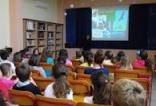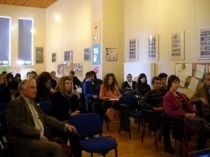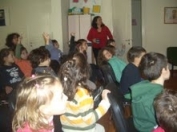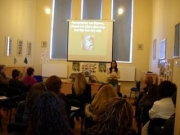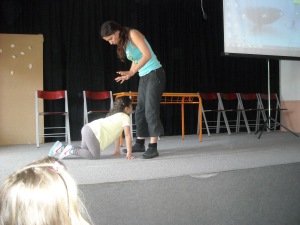Animal Education and Awareness Program in Crete and the islands of the Aegean
Necessity of education and awareness in schools
Companion animal welfare is a growing issue in Greece with serious implications in many areas of cultural, social and economic life. Through our daily volunteer work, we witness countless acts of cruelty, poison and murder especially of stray animals. Despite our efforts the population of stray animals has been decreasing very slowly due to the continuing abandonment and failing to control their reproduction, key points in reducing the problem of stray animals which in turn arises from lack of education and awareness.
Educational Action
It is our deep belief that promoting a new attitude of people towards animals, following the example of other European countries, must start from an early age and inside school. During 2009-2011, the Animal Welfare Society of Chania “Animal Protection” (http://www.animalscare.gr) has been organising awareness campaigns in schools of Chania, with the permission of the Ministry
of Education and in cooperation with the competent Environmental Education Offices of Primary and Secondary Education of Chania, informing more than 5000 students.
Although the results of the educational actions can never be directly measured, both students, as well as teachers and parents associations have expressed the need for the continuation of the campaign. To address the need for teacher training on how to approach the issue of animals in the classroom, the Animal Welfare Society of Chania “Animal Protection” organised in February 2011 a seminar for educators at the Environmental Education Center of Vamos in cooperation with the Office of Environmental Education of Primary Education of Chania with the participation of 30 teachers.
”LIVING TOGETHER WITH THE ANIMALS”
Toward the end of 2010, at the initiative of Vassilki Christou (Zophoros) and animal behaviourist Melita Lazaratou (Animal Protection) following abuses that took place in Amorgos, the two societies start a pilot phase of the program «Living together with the animals» in an effort to spread the educational work in the Aegean islands, giving priority to areas of frequent animal abuse and in areas where relevant educational work is limited. A series of school visits are organised and interactive presentations are given by Melita Lazaratou, starting with the schools of primary and secondary education of Amorgos with excellent feedback from students and educators.
In spring 2011 the educational campaign expands in other islands of the Cyclades, at the request of teachers and local residents, specifically in Naxos, Koufonisi, Schinoussa, Iraklia, and before the end of the school year a series of additional presentations take place at Primary Education schools of Santorini, Syros, Milos and Ios.
The campaign takes place with the permission of the Ministry of Education and in cooperation with the competent offices of Environmental Education and the local authorities. Overall during the school year 2010-2011 4800 students and 150 teachers participated in the project. Also in Naxos a seminar for teachers was organised in collaboration with local educators where «approaches to the subject of animals in the classroom» were presented. (http://oikokyklades.blogspot.com/2011/03/282.html).
In autumn 2011 the Animal Welfare Society of Chania “Animal Protection” receives permission from the Ministry of Education to carry out the program in all Greek schools and there is a widely expressed interest from several areas.
The year closes with visits to schools of Lesvos and Chios, where 2400 students are informed. A second visit to Chios has been arranged for 2012 in order to continue with the remaining schools and to organise a seminar for teachers and parents.
CONCLUSIONS FROM SCHOOL VISITS IN 2011
Through the experience of educating a total of 7200 students in 2011 we have reached to conclusions which should be taken under consideration in similar efforts:
• Although it seems that schools convey the message that children, as well as adults, need to keep an animal-friendly attitude of love and care for pets, there is great need for a more comprehensive approach concerning their care, as well as to cultivate
respect for other species.
• Through the testimonies of the students it is clear that, although the type of abuse (neglect, permanent chaining, poisoning, abandonment, shooting, hunting) differs in the program areas, the extent and brutality of abuse appears equally everywhere.
• The issue of animals is considered by many as an object which mainly concerns younger ages, while the majority of animal abuse incidents by minors is caused by secondary education students. The burden of school curricula, unfortunately discourages secondary schools to participate equally in the program and address an issue that concerns all of us.
• Students of all levels treat the issue of animals (pets and others) with great attention and interest as long as, apart from information, they are given through questions and discussion the chance to reflect on it.
• Students of all ages are willing to engage in activities to raise awareness concerning animal abuse in the local community, as long as they are given the appropriate stimulus through discussion and find appropriate response from educators.
• It is necessary to conduct training seminars for teachers, especially for those who haven’t had experience in environmental education program, on how to address the issue of animals in the classroom in a comprehensive and effective manner.
• There is an urgent need to engage more members of animal welfare societies in the educational activities who, after appropriate training, will undertake informing schools in their region, so that the visits are more frequent.
What does a school visit involve?
School visits last one class period and include three different programs suited to the age of pupils:
i) High School Students. The program includes a presentation about the myths concerning all animals with references to biology and behaviour, and through discussion examines the human relationship with them. Through role-playing students are invited to experience issues arising in the local community and work out what they can do to prevent and stop animal abuse.
ii) 3rd-6th grade. The program includes interactive presentation on the principles of behavior and biology of companion animals, their rights and our obligations towards them. Through examples of good practice we learn how to take care of them responsibly and according to their needs, and how we can deal with animal abuse. Children are also asked to think whether animals can be happy, in the case of exotic species and species that are being exposed to circuses and zoos. The children are asked undertake actions to inform their classmates, family and neighborhood with the support of the educators and the speaker.
iii) Kindergarten, 1st and 2nd grade. The program for these ages includes a 20 minute interactive presentation about companion animals with a short reference to exotics, animals in zoos and circuses. They are asked to think what “makes a good friend” and apply these principles to their animal companions. Through images and narrative we learn how to take care of them based on their needs, how to read body language, and how to approach them with safety. Then children draw cats and dogs and what they need to live happily. The goal at this age is to lay the foundations for the creation of a responsible attitude towards animals.
The educational program is supported by European Sustainability Academy and Attica Animal Hospital
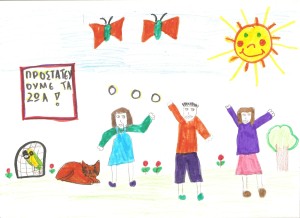
Γ τάξη – Δ.Σχ. Λιβαδίων Χίου
Animal Welfare Education and Awareness Program
«Living with the animals”
in Crete and the islands of the Aegean
2012 Report
Animal Welfare Association of Chania
“Animal Protection”
NGO Zophoros Heraklion
Panhellenic Federation of Animal Welfare and Environmental Organisations
Panhellenic Coordination Committee of Animal Welfare Unions
Νecessity of education and awareness in schools
The animal welfare issues of Greece, concerning companion and other animals, as well as their implications in many areas of cultural, social and economic life have been raised and addressed during the past few years by Greek animal welfare groups. However, during these socially and economically difficult times animal welfare issues are often treated as a last priority in a long list of problems by a big part of society. Through their daily work animal welfare volunteers witness countless acts of cruelty, poison and murder especially of stray animals.
Despite the severity of the Greek social problems we can not see a better future for animals if we do not create now a basis for a more respectful attitude towards all living beings through education. At the same time the financial resources for education in Greece are currently scarce and school activities are often restricted to the obligatory curriculum. Animal welfare societies through the program Living with the Animals (sumvionometazoa.wordpress.com) are meeting this educational need, aiming to benefit animals, children, parents and the wider society.
Educational Action
From 2009 until 2011, the Animal Welfare Society of Chania “Animal Protection” (http://www.animalscare.gr) has organised awareness campaigns in schools of Chania, with the permission of the Ministry of Education and in cooperation with the competent Environmental Education Offices of Primary and Secondary Education of Chania, informing more than 7100 students and 375 educators.
Since 2010 the program expanded in other areas in an effort to spread the educational work in the Aegean islands, giving priority to areas of frequent animal abuse and in areas where relevant environmental education programs are limited. Until the end of 2011 5564 students and more than 290 educators in the islands of the Cyclades and the North Aegean (Chios and Mutilini) participated in the program. (see 2011 report)
”LIVING WITH THE ANIMALS” 2012
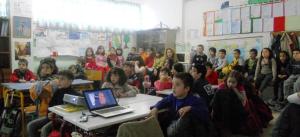 Educational visits at schools continued during 2012 with the support of European Sustainability Academy. During February a Living with the Animals educational campaign was organised in schools of Municipality of Malevizi, Heraklio in cooperation with NGO Zophoros Heraklion and the Municipality of Malevizi with the participation of 1850 students and 84 educators from kindergarten, primary and high schools. Mayor of Municipality of Malevizi Mr. Kostas Mamoulakis as well as Vice Mayor Mr. Petros Petrakis visited 1st Primary School of Gazi in order to answer children’s questions on the issue of stray animals in their area.
Educational visits at schools continued during 2012 with the support of European Sustainability Academy. During February a Living with the Animals educational campaign was organised in schools of Municipality of Malevizi, Heraklio in cooperation with NGO Zophoros Heraklion and the Municipality of Malevizi with the participation of 1850 students and 84 educators from kindergarten, primary and high schools. Mayor of Municipality of Malevizi Mr. Kostas Mamoulakis as well as Vice Mayor Mr. Petros Petrakis visited 1st Primary School of Gazi in order to answer children’s questions on the issue of stray animals in their area.
In March, after the prior successful visits in schools of Chios in 2011, a second series of school visits was organised in cooperation with the Chios Animal Welfare Society, this time in more central schools of the island with the participation of 1663 students and 76 educators. From April until the end of the school year an additional 1155 children and 53 educators participated in the program in the schools of Chania prefecture.
In September 2012 a new application was made to the Ministry of Education and was approved for the area of Crete allowing the program to begin in November with schools of Chania with the participation of 556 children and 25 educators with the support of the Municipality of Chania which also participated in the design and printing of the first program leaflet. The Panhellenic Federation of Animal Welfare and Environmental Organisations proceeded with meeting with the Minister of Education in order to discuss the further approval for other areas which were agreed for spring 2013.
CONCLUSIONS FROM SCHOOL VISITS IN 2012
Through the experience of educating a total of 5524 students in 2012 we have reached\to conclusions which should be taken under consideration in similar efforts:
• Although animal welfare issues are mentioned in class through literature and environmental classes there is a need for further discussion and a more comprehensive approach concerning their care, as well as to cultivate respect for other species. The question of whether “humans are also animals” seems to be a puzzling one for a large percentage of students both of primary and secondary education.
• School initiatives that put animal welfare into practice such as adopting a stray dog/cat and finding a caring home for them makes children more receiving during the Living with the Animals School visit, where they can discuss the responsibilities and the difficulties of taking care of a pet while sharing the happy moments. Pupils learn how to share responsibility, how to safely approach and pet an animal, as well as not be afraid of them. These initiatives should be accompanied by informing parents and educators.
• The issue of animals is considered by many as an object which mainly concerns younger ages, while the majority of animal abuse incidents by minors are caused by secondary education students. The burden of school curricula, unfortunately discourages secondary schools to participate equally in the program and address an issue that concerns all of us.
• Through the testimonies of the students it is clear that they are often exposed to incidents of cruelty towards animals (neglect, permanent chaining, poisoning, abandonment, shooting, hunting, dog fighting). Through education we hope to put an end to this cruelty in the future but these incidents have to be addressed by society now.
• Educators’ support plays an essential role in continuing relevant actions after the school visit is over.
• It is necessary to conduct training seminars for teachers, especially for those who haven’t had experience in environmental education programs, on how to address the issue of animals in the classroom in a comprehensive and effective manner.
• There is an urgent need to engage more members of animal welfare societies in the educational activities who, after appropriate training, will undertake informing schools in their region, so that the visits are more frequent.
What does a school visit involve?
School visits last one class period and include three different programs suited to the age of pupils:
i) High School Students. The program includes a presentation about the myths concerning all animals with references to biology and behaviour, and through discussion examines the human relationship with them. Through role-playing students are invited to experience issues arising in the local community and work out what they can do to prevent and stop animal abuse.
ii) 3rd-6th grade. The program includes interactive presentation on the principles of behavior and biology of companion animals, their rights and our obligations towards them. Through examples of good practice we learn how to take care of them responsibly and according to their needs, and how we can deal with animal abuse. Children are also asked to think whether animals can be happy, in the case of exotic species and species that are being exposed to circuses and zoos. The children are asked undertake actions to inform their classmates, family and neighborhood with the support of the educators and the speaker.
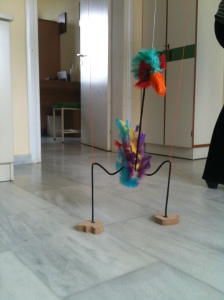 iii) Kindergarten, 1st and 2nd grade. The program for these ages includes a 20 minute interactive presentation about companion animals with a short reference to exotics, animals in zoos and circuses. Children are asked to think what “makes a good friend” and apply these principles to their animal companions. Through images and narrative we learn how to take care of them based on their needs, how to read body language, and how to approach them with safety. Then children draw cats and dogs and what they need to live happily. The goal at this age is to lay the foundations for the creation of a responsible attitude towards animals.
iii) Kindergarten, 1st and 2nd grade. The program for these ages includes a 20 minute interactive presentation about companion animals with a short reference to exotics, animals in zoos and circuses. Children are asked to think what “makes a good friend” and apply these principles to their animal companions. Through images and narrative we learn how to take care of them based on their needs, how to read body language, and how to approach them with safety. Then children draw cats and dogs and what they need to live happily. The goal at this age is to lay the foundations for the creation of a responsible attitude towards animals.
The continuation of the program for 2012 would not have been possible without the valuable support of European Sustainability Academy (http://eurosustainability.org)
For further information on Living with the Animals please contact: melitalazaratou@gmail.com, sumvionometazoa.wordpress.com

